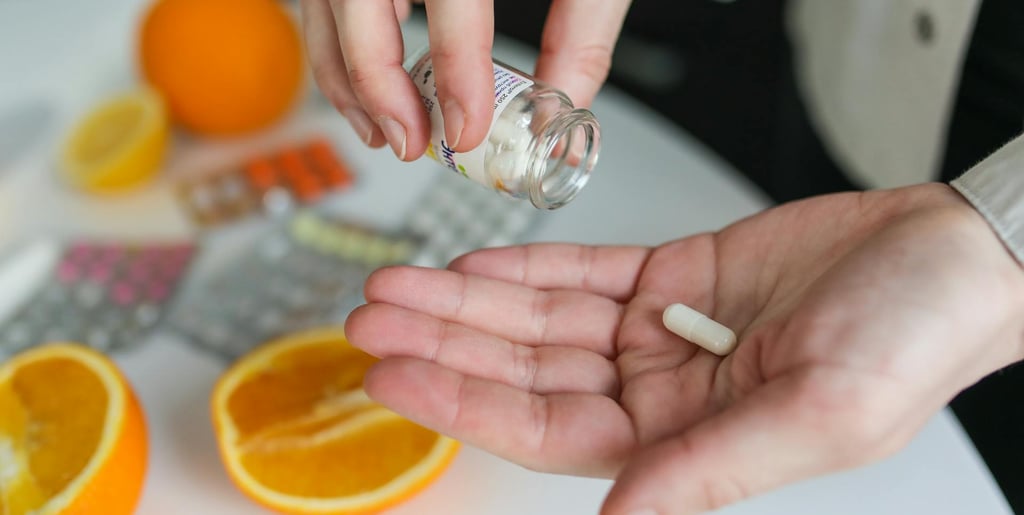

The Dangers of Over‑Supplementing
I still remember the day I cracked open my medicine cabinet and counted twelve different supplements—everything from collagen shots to “brain‑boosting” nootropics. I lined them up like a science experiment, convinced that if I just found the perfect combination, I’d unlock some next‑level version of myself. But instead of feeling supercharged, I ended up jittery, anxious, and downright overwhelmed.
That’s when I dug into the science and nearly fell off my yoga mat: the FDA estimates over 42,000 cases of supplement‑related toxicity were reported in 2021, and a whopping 23,000 Americans wind up in the ER each year from adverse reactions like chest pain, severe headaches, or dangerous blood‑pressure spikes .
Yes, those pretty, pastel‑colored capsules can pack a serious punch—one that doesn’t always show up on the label.
Back then, I believed wellness meant stacking every “must-have” supplement, hoping for miraculous results.
💡 Things to take with you
Track how you feel—your sleep quality, hunger cues, and natural energy ebbs and flows—rather than leaning on another supplement to “fix” you.
Create a soothing evening routine (dim lights, light stretching, herbal tea) and stick to consistent bedtimes to boost rest and next‑day alertness.
Aim for three nutrient‑rich meals daily—colorful fruits and veggies, lean proteins, whole grains—to stabilize blood sugar and prevent crashes.
Swap high‑intensity marathons for morning yoga flows, afternoon walks, or any activity that feels joyful and sustainable.
Use vitamins or minerals only when they fill a documented gap—under professional guidance—and never as a substitute for the basics of sleep, nutrition, and movement.
So here’s the deal:
I traded my cocktail of pills for a simple experiment in listening—no tracking apps, no flash‑in‑the‑pan powders. I focused on the basics: how I slept, when I felt hungry, and what my energy actually looked like throughout the day.
What I discovered felt almost revolutionary: by honoring my body’s own signals, I found a steadier, more sustainable kind of energy—one that no supplement bottle could ever replicate.


Can popular vitamins actually be risky and cause real damage to my health?
Supplements are big business.
From Instagram‑ready gummy vitamins to sleek, metallic tubs of powders, it’s easy to fall for the promise of a perfect solution in a capsule. Yet this promise can obscure real dangers:
Emergency room visits: Analysis of decade‑long surveillance data reveals that dietary supplements frequently prompt emergency visits for reactions ranging from allergic responses and gastrointestinal distress to toxic exposures.
⚡️ Over one in ten of these cases leads to hospital admission, with older adults especially at risk—including choking or swallowing difficulties from oversized pills.
Despite widespread perceptions of safety, the lack of pre‑market safety testing and mandatory side‑effect labeling means many users and clinicians remain unaware of the potential harms.
✦ To protect yourself, scrutinize supplement labels, discuss all supplements with your healthcare provider, and discontinue use at the first sign of adverse symptoms
Contaminants and unlisted ingredients: The FDA has repeatedly uncovered weight‑loss and muscle‑building supplements tainted with harmful chemicals, pesticides, or heavy metals—sometimes linked to liver damage, stroke, or even death.
Financial drain: A Harvard Health article warns that many supplements offer little benefit yet carry hefty price tags—money that might be better spent on whole foods or experiences that truly nourish.
When we chase every “prettiest” bottle off the shelf, we can wind up paying far more than we bargained for—physically and fiscally.
⚠️ Snapping up every eye‑catching supplement can quickly drain your wallet—and your well‑being.
Beyond steep price tags, stacking random pills raises the risk of nasty side effects like digestive upset or dangerously high nutrient levels. Worse, these over‑the‑counter fixes often fly under the radar of rigorous safety checks, leaving you exposed to unlisted ingredients.
Ultimately, chasing that “miracle” bottle can cost you far more in doctor visits and health headaches than it ever saves.


What happens if I take too much of the fat‑soluble vitamins?
Unlike water‑soluble nutrients, fat‑soluble vitamins (A, D, E, and K) accumulate in the body—and in excess, they can become toxic:
Vitamin D overdose can lead to hypercalcemia—too much calcium in the blood—which may cause kidney stones or arterial deposits.
High doses of beta‑carotene, a precursor to vitamin A, have been linked to an increased risk of lung cancer in smokers.
Similarly, the CARET study—combining high doses of β‑carotene and retinol—was halted early after showing increased lung‑cancer cases and overall mortality among smokers receiving the supplements
Vitamin E in excess may elevate the risk of bleeding strokes due to its blood‑thinning effects.
A meta‑analysis of randomized controlled trials found that high‑dose vitamin E supplementation increased the risk of hemorrhagic stroke by about 22%, even as it only modestly reduced ischemic stroke risk.
⚡️ In absolute terms, this translates to one additional hemorrhagic stroke for roughly every 1,250 individuals taking high‑dose vitamin E, underscoring why indiscriminate use of such supplements should be approached with caution.
More broadly, recent data show over 42,000 cases of vitamin toxicity reported in the U.S. in 2021, underscoring how easily we can tip the scales from “beneficial” to “harmful”.
These fat‑soluble vitamins require far more judicious use than their water‑soluble counterparts, so it’s safest to prioritize nutrient‑rich foods and only consider high‑dose supplements under professional guidance.
Always discuss any new supplement regimen with a healthcare provider—especially if you have chronic conditions, take medications, or smoke—so your individual risks can be properly assessed.
By focusing on balanced meals, sensible sun exposure for vitamin D, and routine lab monitoring, you can maintain optimal nutrient levels without flirting with toxicity.


Are “All‑Natural” Supplements Really Safe? The Hidden Risks of Unregulated Pills
Many of us assume that “natural” equals safe—but supplements aren’t held to the same rigorous standards as prescription drugs:
Dangerous interactions: Certain herbs or vitamins can undermine prescription medications (e.g., vitamin K interfering with blood thinners). Beyond just vitamin K, many popular supplements can disrupt prescription drugs in surprising ways.
For example, Coenzyme Q10 has been shown to speed warfarin metabolism , which can reduce its anticoagulant effect and raise clotting risk.
Garlic’s ajoene component irreversibly inhibits platelet aggregation—potentiating anticoagulants such as warfarin and clopidogrel—by blocking key platelet activation pathways.
Likewise, ginkgo biloba extract has been associated with a 38% higher risk of bleeding events when taken alongside warfarin in large observational studies.
Regulatory blind spots: Unlike drugs, supplements don’t require pre‑market approval.
⚡️ Studies have found hidden stimulants in weight‑loss pills and anabolic steroids in muscle‑building products.
As a result, dozens of weight‑loss pills have been found to hide amphetamine‑like stimulants such as BMPEA and DMAA—compounds tied to dangerous spikes in blood pressure and heart risks.
And in an international analysis, “herbal” weight‑loss supplements sold in the UAE were found to contain fluoxetine, phenolphthalein, and sibutramine—prescription medications that never should have slipped past regulators.
Whether it’s a seemingly innocent herb that throws your prescription off balance or a hidden stimulant lurking in a weight‑loss capsule, you deserve to know exactly what you’re taking.
⚠️ These regulatory gaps mean that “all‑natural” doesn’t automatically equal “all‑safe.”
Always choose trusted brands with third‑party testing, read labels carefully, and—most importantly—check in with your healthcare provider before adding any supplement to your routine.
Gentle routines to keep my energy up instead of relying on caffeine or powders
Swapping a good night’s sleep for stacks of supplements seemed like a shortcut—until I realized my energy nosedived without the basics in place.
I’ve found lasting vitality by tuning into my body’s natural rhythms:
Sleep as a sanctuary.
Rather than grabbing a sleep aid, I honor a consistent bedtime and gentle evening routine—dim lights, light stretching, and a mug of herbal tea.
My energy feels steadier, and I wake up more refreshed than any pill could promise.
🔎 Research shows that keeping regular sleep–wake times not only increases the total amount of sleep but also enhances sleep quality and next‑morning alertness—benefits that pills simply can’t guarantee.
Joyful movement.
Swapping “push‑through” workouts for morning yoga flows or afternoon walks in the park keeps me energized without the wear‑and‑tear of extremes.
⚡️ Even 20 minutes of moderate exercise can boost mood for up to 12 hours.
Balanced meals.
Instead of snacking on protein powders, I savor three nourishing meals a day—colorful fruits and veggies, lean proteins, and whole grains. No more mid‑afternoon crashes or late‑night junk binges.
🔎 A controlled trial in healthy adults comparing low (3 meals/day) versus high (14 meals/day) feeding frequencies found that sticking to three meals not only improved glycemic control and resting metabolic rate but also significantly increased satiety and reduced hunger—helping prevent those mid‑afternoon energy crashes and late‑night snack binges.
Hydration, unhurried.
I carry my water bottle everywhere, sipping throughout the day. Mild dehydration—even 1–2% body water loss—can impair focus and mood.
Mindful breaks.
A five‑minute breathing exercise or a quick walk around the block resets my system far better than popping another supplement.
Together, these simple habits form the foundation of real, lasting energy—no fancy pills required.
By giving your body regular rest, joyful movement, balanced fuel, steady hydration, and mindful pauses, you honor its natural rhythms instead of fighting them.
That’s your body’s rhythm reminding you it needs energy input.
💡 Start small:
Pick one habit this week—maybe a consistent bedtime or a five‑minute walk—and build from there.
Over time, you’ll notice your energy stabilize, your mood brighten, and those mid‑day slumps become a thing of the past.


